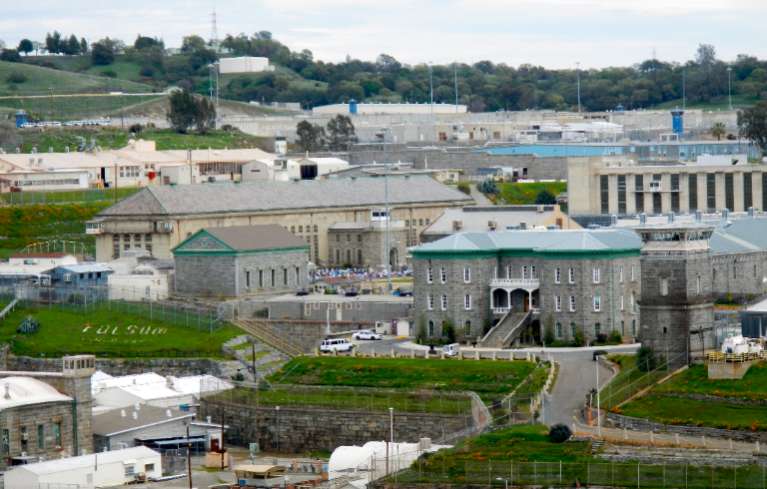Museum captures life inside Folsom Prison

Folsom Prison from across the American River at the Folsom Lake State Recreation Area. Photos/Kathryn Reed
By Kathryn Reed
REPRESA – While Johnny Cash didn’t really shoot a man in Reno just to watch him die, he has been to Folsom Prison. It was to give a concert.
He is credited with making the prison famous beyond the inmates and riots.
Every vehicle owner in California is driving around with a piece of Folsom prison. Since 1947 the facility has been making the state’s license plates; 40,000 are made a day.
People can get a sense of the institution’s history and what it might be like today to be behind bars through the prison museum, which is on the prison grounds.
On the road in there is a sign that says, “No stopping or turning on prison road: Warden.” What happens if you do isn’t known.
The 1,000 acres are initially pastoral, welcoming, even.
“In custody inmates do the mowing,” Pino Ramacher tells Lake Tahoe News. Ramacher retired as a correctional sergeant in 2005 and now works at the museum.
Prison labor is also used to maintain the gardens.
Across the river is a walking path with views of the prison. It also means the prisoners have views of freedom that are beyond their reach.
Arriving at the prison, the first building is where visitors check in. A long list of attire is not permitted – no blue clothing, no shorts, no hats, no clothes with logos, no toe strapped sandals, and no metal underwire on bras. People cannot take in purses, food, cameras, make-up, pennies or gum.
A line on the ground leads to the museum. And at the far end of the museum is another line. It’s to stop people from going farther onto the grounds. A stone’s throw away is the prison gate. It’s not known if sirens wail and the person stepping across that line would be carted off in handcuffs.
In many ways the outside looks like some ornate castle because of all the stonework. All native stone was used to build the facility and inmates handcrafted it.
Their handiwork can also be seen along Highway 50 leading to South Lake Tahoe. The inmates made the granite mile markers.
“We had our own power plant. We had a quarry where all the stone for the prison came from. Much of it was dug out by hand,” Ramacher said. “There’s a lot of detail in the rock.”
The first inmates arrived on July 26, 1880. They came from San Quentin, which was overcrowded. That is why Folsom was built.
A movie gives some details about the early years as well as a tour of inside the prison.
Artifacts in the museum include a wealth of weapons inmates have made and ones that were smuggled in. The gun used in 1937 during a riot where Warden Clarence Larkin was killed is included in the display.
It used to be that prisoners could be buried on the grounds, but that has not happened since 1959.
The plan is for this 900-square-foot museum to be replaced by a 35,000-square-foot museum that will have information from prisons across the country. That could happen in three years.
—-
Other things to know:
• There are other ways into the prison besides committing a crime or visiting someone who did. The annual Race Behind Bars mountain bike race is May 18. More info is online.
• The Johnny Cash Trail broke ground in February. The 2.5-mile trail will cross prison grounds and link El Dorado and Placer counties to the American River Parkway as well as to Folsom’s historic district. It should open in a year.
• The $3.8 million overcrossing at Folsom Lake Crossing Road will be built to resemble the prison’s guard towers.
• Museum fee is $2.
• Museum is open daily 10am-4pm, except for Thanksgiving, Christmas and New Year’s Day.
• More info is online.



